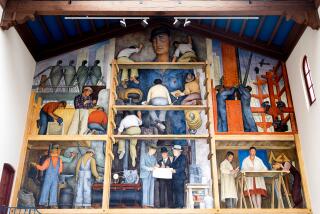Koshalek packs along the globe
Richard Koshalek says that it still smarts that he got dumped as president of Pasadena’s Art Center College of Design and that he intends to remain a networker par excellence in his new job as director of the Smithsonian Institution’s Hirshhorn Museum and Sculpture Garden.
Koshalek’s penchant for forging national and global connections was used against him during the campus coup that led to his ouster last year at Art Center. “I believe isolation breeds irrelevance. You have to be engaged in the larger context,” Koshalek, 67, said after Thursday’s announcement of his new job.
In his old job, that philosophy led Koshalek to host international design conferences on campus and to conceive a series of “global dialogues” that Art Center would coordinate overseas, addressing the role of design in society. Only one took place, however, last March in Barcelona. Meanwhile, Koshalek oversaw the creation of a satellite campus and student housing in South Pasadena and was raising money for a $50-million Frank Gehry-designed research center that has since fallen into limbo.
Last spring, an anti-Koshalek group of students, faculty and alumni, galvanized by his request for a contract extension, argued that his expansive vision and global reach had become too rich for the elite school’s blood. Instead, critics said, resources needed to be focused close to home, on classroom learning and on easing the burden borne by students paying nearly $120,000 in tuition for their degrees.
In June, the college’s board of trustees voted not to give Koshalek his extension, and sidetracked the Gehry building and other expansion plans. In September the trustees accepted his resignation rather than hold him to a contract through the end of 2009.
Ironically for an arts leader who is committed to forging global connections, Koshalek’s downfall at Art Center was a textbook case of the power of instant electronic connectivity. It started with a dissatisfied student blogging and quickly grew into an online petition drive calling for a change in leadership and direction that drew support from alumni around the world, some of them high-ranking figures in design.
It rankles Koshalek that, along with those who gave their names on the Internet site set up by his opponents, many anonymous criticisms were made, and false rumors and suppositions were passed along. Early on, student outrage was fed partly by the mistaken notion that money for the Gehry building was being siphoned from scholarships and instructional budgets. In fact, a separate capital campaign was in progress to raise the $50 million.
“It’s an interesting question now, the subject of leadership [while] surrounded by anonymous voices,” Koshalek said. “I wasn’t a villain there. I wasn’t trying to destroy the institution. I was trying to build the institution. Nine years of work was erased in a moment, in an orchestrated campaign against me. . . . It became quite painful. What happened took its toll.”
His ouster put Koshalek in play and on the radar of the Hirshhorn, whose former director, Olga Viso, had left in 2008 to head the Walker Art Center in Minneapolis.
J. Tomilson Hill, chairman of the Hirshhorn board, said the very things that got Koshalek in trouble in Pasadena made him attractive in Washington. “Those attributes . . . looking externally and being involved in growth, that’s what we were looking for at the Hirshhorn.”
Hill said the museum’s search committee talked to past and present Art Center trustees while vetting Koshalek and concluded “it was just a difference in direction,” rather than a lack of stewardship, that led to his being unhorsed in Pasadena.
Koshalek said what drew him to the Hirshhorn when its search committee contacted him late last year was the sense of energy and opportunity emanating from the capital because of the ascendancy of Barack Obama. He said he aims to run the Hirshhorn, which collects and shows art from the late 19th century to the present, with “an expanded view of the role of a museum in the nation’s capital.”
He sees himself cultivating international ties and making the museum a forum for ideas, much as he had at Art Center. He’ll reach out to foreign embassies and the myriad think tanks that reside in the capital. Koshalek previously worked in Washington from 1972 to 1974 as director of visual arts programs at the National Endowment for the Arts. He said he plans to keep his home in Pasadena, and “we’ll be coming back often.”
--
More to Read
The biggest entertainment stories
Get our big stories about Hollywood, film, television, music, arts, culture and more right in your inbox as soon as they publish.
You may occasionally receive promotional content from the Los Angeles Times.










